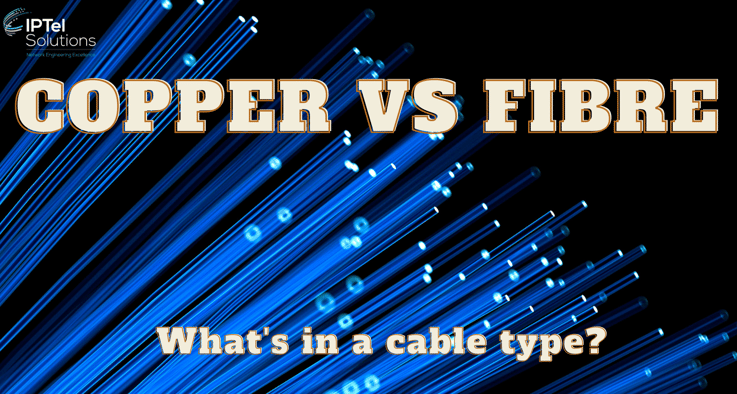What's in a cable type? In this blog, we'll give you some basic information on the types of cabling you might see when installing networking equipment.

Cabling and patch cords are a fundamental part of networking. Without these, there would be no networking, so if you're starting out on your networking career, hopefully this blog helps with a little familiarisation of the difference between copper and fibre patch leads.
ASSOCIATED BLOGS:
Twisted Pair Copper Cabling
Copper ethernet cabling is the most common cable type you see. It consists of 4 pairs (8 individual wires) of copper wires that are twisted in a specific way to reduce problems with cross-talk and other issues caused by having wires in close proximity to each other.
Ethernet is often referred to simply as UTP (Unshielded Twisted Pair), but can also come as STP (Shielded Twisted Pair), which adds an outer layer for protection from external interference and physical damage.
More rarely, it’s possible to get weatherised ethernet cables that can be installed in in outdoor environments (note: “jelly-filled” does not mean edible!)
The standard connector for UTP uses a standard jack format called RJ-45, which has 8 pins that are all connected in a consistent manner.
One key benefit of copper cabling is that it can also transmit power as well as data, up to 100m in length.
Always keep an eye out for cables that have the same RJ-45 jack, but don’t have the correct wiring scheme. Crossover cables use a different scheme on either end.
ASSOCIATED BLOGS:
- Increasing AP Density
- Wi-Fi Surveys (Overview to the various types of RF Surveys)
- Wi-Fi Phone Dropouts
- Wi-Fi Surveys
Twisted Pair Categories
Twisted Pair cabling is graded by category, from category (“CAT”) 1 to 7, as standard and technologies improve over time.
Category 5e is mostly seen in older sites and still selected for low-cost new deployments, but Category 6 is the most appropriate category for modern enterprise networks.
Category 7 has been defined, but it’s not currently used in practice as there isn’t a great demand for such high throughput over copper.
The Ethernet standard sets the maximum supported run for any category as 100m. You should always consider any patch cables used and other passive cable extensions as part of that limit.
ASSOCIATED BLOGS:
Fibre Optic Cabling
Fibre optic cabling uses light at a specific frequency to transmit digital signals between network devices.
Saying fibre is a common way of describing optical cabling. It is important to note that fibre cabling is also a formal Ethernet cable type. When discussing ethernet cables, always qualify the type of cable you’re referring to..png?width=204&height=204&name=Anatomy%20of%20an%20Access%20Point%20(Instagram).png)
A fibre optic cable consists of a single clear wire, with a light emitting transceivers on each end.
Most transceivers use the SFP form factor to connect to a network device to allow freedom to choose the most suitable connection type for each cable run.
Whereas copper cabling always has an attached connector, fibre cables can be found with pluggable fibre and connectors, or as a pre-made single part.
There are two main types of fibre cabling:
- Single mode, which is well-suited to long distances.
- Multi-mode, which is less expensive to use.
The mode used will affect the SFP connector and then the properties of the cable.
Fibre cabling has two key benefits:
-
Optical cables do not suffer from RF interference and don’t require any shielding for RF protection
-
The distance that can be crossed with a single cable can be many kilometres.
A drawback of Fibre is that it cannot send power over the same line, requiring power to be supply separately (or for an additional cable to be woven in that can supply appropriate power)
Fibre optic cabling is often laid in bundles of multiple strands. the type of strand used will determine whether it supports single mode or multi-mode.
ASSOCIATED BLOGS:
Copper vs Fibre: Summary
One of the most basic building blocks in networking is the humble patch lead. We often overlook the back end cabling we use to build a network, but understanding its properties and when you should copper or fibre cabling is worth knowing.
.gif?width=198&height=198&name=Wi-Fi%20and%20the%20Cinema%20Story%20(Instagram).gif) This is a basic introductory blog, but the concepts will help you in your networking career as you can talk with a little more authority on what each cable type is, what it does and when you'll use it.
This is a basic introductory blog, but the concepts will help you in your networking career as you can talk with a little more authority on what each cable type is, what it does and when you'll use it.
Speeds are ever increasing on all cable variants of course - and so new standards, as well as ever more exacting methods of install are required to keep pace.
Hopefully this blog has been of some use in briefing you on the most basic element of networking, the physical, or Layer 1 level.
As ever, if you need support with your design and install, drop us a line at sales@iptel.com.au
ASSOCIATED BLOGS:
- Wi-Fi Predictive Designs
- Wi-Fi Assurance Review
- Wi-Fi 6E and 6GHz Explained
- Wi-Fi 6 vs 5G
- Wi-Fi Surveys: Overview to Wi-Fi Survey types


.gif?width=203&height=203&name=Wi-Fi%20Assurance%20Review%20(Instagram).gif)


.gif)
.gif)